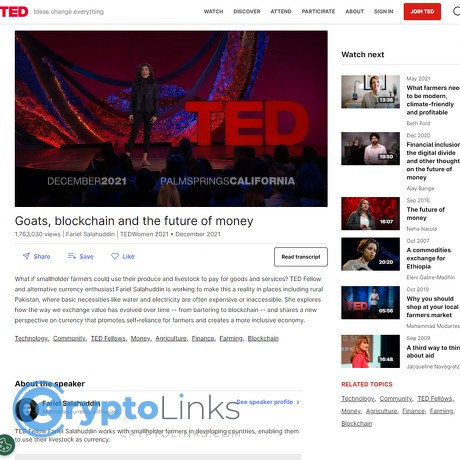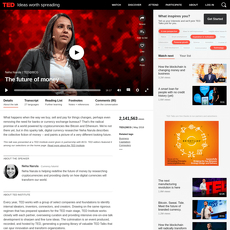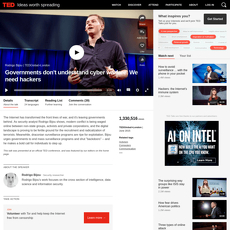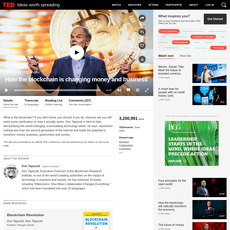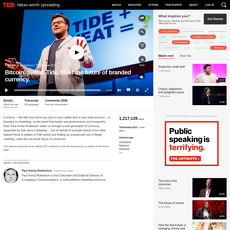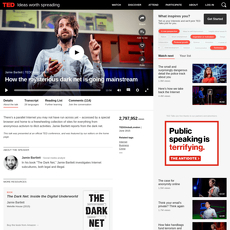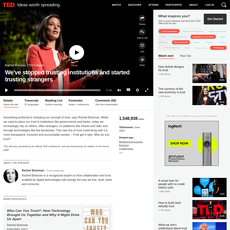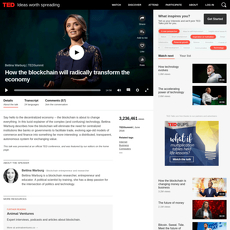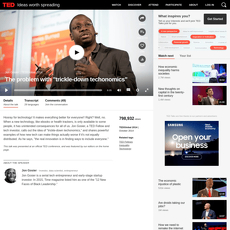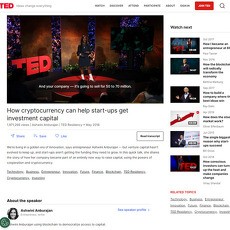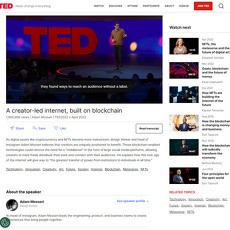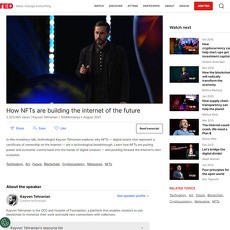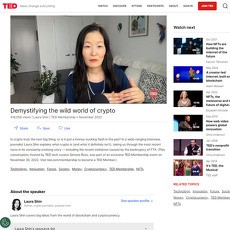Fariel Salahuddin: Goats, blockchain and the future of money Review
Fariel Salahuddin: Goats, blockchain and the future of money
www.ted.com
Fariel Salahuddin: Goats, Blockchain, and the Future of Money — Review Guide + FAQ
Can goats really power the future of money? Wild question, right. But if you’ve watched Fariel Salahuddin’s TED talk, you’ve seen a surprisingly practical idea: turn livestock into a trusted way to pay for water, electricity, and other essentials—then use blockchain as the transparent record-keeper.
I’m going to make this simple and hype-free. No crypto buzzwords, no hand-waving. Just a clear look at the problem, the promise, and what’s actually workable on the ground.
Describe problems or pain
Let’s start with the reality most crypto projects skip:
- Billions are still unbanked or underbanked. The World Bank’s Global Findex estimates around 1.4 billion adults don’t have a bank account. Cash is king—but it’s fragile.
- Cash breaks—often. When cash runs short, life stalls. Think of Nigeria’s 2023 cash crunch during the naira redesign—ATMs dry, payments delayed, livelihoods squeezed (Reuters).
- Local currencies can be volatile. Savings evaporate in weeks. In rural areas, people naturally park value in what they trust—typically livestock.
- Utilities can’t get paid on time. Power and water providers struggle with collections and “leakage.” In several African markets, electricity distribution companies report high aggregate technical, commercial, and collection losses—a recipe for unreliable service and stalled expansion.
- NGOs and funders still run on spreadsheets and trust. Money goes in; results come out (maybe). The audit trail is fuzzy, the reconciliation slow.
- Crypto ignores the people without data plans. If your design assumes smartphones and always-on internet, you’ve already excluded millions. Yet USSD and agent networks still move serious value—GSMA counted 2 billion+ mobile money accounts globally, much of it running over basic feature phones.
Here’s the kicker: in many rural economies, goats are money. They reproduce, they’re tradable, and they store value people trust. The question is how to turn that existing wealth into on-time payments for essential services—without predatory middlemen or messy IOUs.
Promise solution
That’s where Fariel’s goat-for-utilities model comes in. I’ll explain, in plain English, how it could work—and where blockchain actually helps:
- Transparency: clean, auditable records everyone can see
- Programmable rules: partial payments, schedules, and automated settlements
- Community trust: shared ledgers that reduce disputes and leakage
I’ll also show what it takes to make livestock-backed payments real: fair valuation methods, clear custody rules, and local governance that actually fits how people live.
And yes, I’ll answer the questions I get all the time: Is this just bartering with extra steps? Which chain makes sense? How do you handle people without smartphones? What about price volatility, or animal health?
Who this guide is for
- You want crypto that solves real problems—not just speculates on them
- You work in energy or water access and need more reliable collections
- You care about financial inclusion and asset-backed payments in rural economies
- You’re curious how bartering can be upgraded with modern rails
What you’ll get
- A quick, readable summary of the big ideas behind “goats as money”
- How a goat-to-payment flow could work in the real world (no jargon)
- The genuine benefits, the tough trade-offs, and what’s still unsolved
- My straight-up review—what’s smart and what needs work
- A practical FAQ you can share with your team
Real-world sample: In Pakistan, initiatives like “Goats for Water” have let communities trade livestock value for solar-powered water access. The asset is familiar (a goat), the outcome is tangible (clean water), and the record-keeping can be made transparent. That’s the spirit of what we’re exploring here.
Curious what Fariel actually lays out in the talk—and how goats, bartering, and blockchains fit together step by step? That’s exactly what I’m unpacking next. Ready to see the core ideas stripped of hype?
What Fariel actually says in the TED talk
Here’s the simple, powerful thread I heard: in places where cash is scarce or unreliable, goats (and other livestock) are real money. People already save, trade, and settle obligations with animals. So why not let households use that wealth to pay for essentials like water and electricity—without predatory middlemen or messy paperwork? That’s where a blockchain ledger steps in: not as hype, but as the trust layer that records what was pledged, what was delivered, and who gets paid, in a way everyone can verify.
“A goat is a savings account on four legs.”
Key ideas in one glance
- Livestock is money for millions. It’s liquid at local markets, it reproduces, and it’s understood by the whole community.
- Barter isn’t broken—it just needs better rails. Clear rules and transparent records make barter usable at scale.
- Blockchain is the public clipboard everyone can trust: it tracks value, timestamps agreements, and reduces leakage without relying on a single middleman.
Why goats, not just cash or mobile money
Goats aren’t a gimmick. They’re practical, productive assets that many rural households already own. In a lot of regions, a small herd is safer and more familiar than a bank account 50km away.
- Productive store of value: goats breed, creating future value. That’s a built-in yield most bank accounts can’t match in rural settings.
- Local liquidity: livestock sells fast at weekly markets with known prices, even when cash is tight.
- Lower entry barrier: families can start with one or two animals—no paperwork, no minimum balance.
- Resilience vs. currency risk: when the local currency fluctuates or inflates, livestock often holds value in local terms. ILRI notes over a billion people rely on livestock for income and food security, and livestock can make up a large share of rural household assets in low-income countries (ILRI).
- Mobile rails aren’t universal: Kenya’s M-Pesa is famous, but many markets still face agent liquidity gaps, ID/KYC hurdles, and patchy coverage. Global Findex 2021 estimated 1.4B adults remain unbanked, and mobile money usage is uneven across countries (World Bank Findex; GSMA Mobile Money).
So when a pump operator or mini-grid needs reliable payments, goats aren’t “old-fashioned”—they’re the most honest balance sheet a family has.
Where blockchain fits (and where it doesn’t)
Fariel frames blockchain as the boring-but-essential layer that keeps everyone honest:
- Auditable records: who pledged which animal, when, and at what agreed value—logged for the community, utility, and funders to see.
- Programmable rules: milestone-based credits (e.g., water hours or kWh), automatic release schedules, and shared oversight by a village committee.
- Reduced leakage: less room for “lost” payments or disputes over who paid what, because the ledger says so.
But she’s clear about limits. A ledger can’t fix a broken pump, train a vet, rewrite repossession laws, or override cultural norms. It’s the rail, not the road. Infrastructure, legal frameworks, and local governance still do the heavy lifting.
Who is Fariel Salahuddin
She’s a practitioner who has worked at the crossroads of energy access, rural finance, and local markets. Her focus: unlock the value families already hold—like goats—so they can pay for essential services without predatory terms or endless delays. If you want a name for that approach, it’s simple: use local assets, add transparent rules, deliver real services. You can watch her TED talk here: Goats, blockchain and the future of money.
I know what you’re thinking: great story, but how does a goat actually turn into electricity credits on a ledger without chaos? Stick with me—next, I’ll map the step-by-step flow you can steal for a real pilot, including where the tricky parts live.
How “goats on the blockchain” could work, step by step
“You can’t plug a goat into a socket, but you can plug its value into a community’s water pump.”
Let me walk you through a practical, street-level version of how this actually works. No jargon, no fairy dust—just everyday assets, clear rules, and rails that anyone with a basic phone can use.
The flow
- 1) A household commits livestock as collateral
An agent from the local co-op visits. They register 2–5 goats with simple identifiers: photos, ear tags, weight, approximate age/sex, and owner ID. Think of it like a chattel pledge—ownership stays with the family, but a portion of value is reserved to pay for water or electricity. - 2) Value is assessed and recorded on a ledger
The co-op inputs today’s fair price (from local market data). The ledger locks a conservative percentage as spendable utility credit. Example: three goats at $65 each = $195. With a 60% loan-to-value, the family unlocks $117 of service credit. This can be recorded as a tokenized voucher or just a clear on-chain account entry. - 3) Utility provides service
The water provider turns on hours for the village pump; the mini-grid issues electricity credits. Meters or agents check the household’s balance (via USSD or a printed QR receipt). Every liter or kilowatt-hour is deducted from the pledged credit in small increments. - 4) Value realization and automatic settlement
When a goat is sold (or a kid is born and later sold), the agent logs the sale. Proceeds are split automatically—first to clear the remaining utility bill on the ledger, then the rest back to the family. If no sale happens, a scheduled transfer at the next market day can clear a portion. The rules are pre-agreed and visible to all parties. - 5) Transparent records for the community and funders
A simple dashboard shows: pledged assets, credits issued, services delivered, repayments, and any disputes. A paper slip or SMS confirms each action. Funders and utilities finally get verifiable impact, not PDFs and promises.
Real-world parallel: Pay-as-you-go solar already does the “service now, gradual repayment” dance at scale—GOGLA reports tens of millions of off-grid devices financed this way worldwide. We’re swapping cash installments for asset-backed installments using livestock most households already hold. See GOGLA’s market reports: gogla.org/resources.
Is this just bartering?
It’s bartering with superpowers. The goat isn’t dragged to the pump; its priced, fractional value is. The ledger adds structure and trust:
- Partial payments down to cents, not whole animals
- Schedules that sync with market days and seasons
- Rules for splits, fees, and insurance built into smart contracts
- Oversight so the community sees that prices and repayments are fair
As the International Livestock Research Institute notes, “Livestock are a form of savings and insurance for the poor.” The point is to let families spend that savings on essentials without fire-selling animals or waiting for cash to appear.
Valuation and oracles
Pricing the animal fairly—and updating it—is the beating heart of this model. Here’s a practical, low-cost oracle design I’ve seen work in adjacent projects:
- Tri-source price feed
- Weekly co-op auction prices
- A rotating panel of certified assessors (two out of three must match within a tolerance)
- Crowd-reported market prices via agents, medianized to blunt outliers - Hedonic checks (weight, age, sex, condition) to avoid “one-price-fits-all.” ILRI studies consistently show these traits drive value—see their livestock market research library: cgspace.cgiar.org.
- Haircuts and LTV
50–65% LTV is common for volatile assets. Older or pregnant animals get adjusted haircuts. Prices update weekly; sudden drops trigger grace windows before any enforcement. - Dispute and challenge windows
A 72-hour period lets owners or the utility challenge a price. If a reassessment proves manipulation, the offending oracle loses a staked bond and reputation. Keep it simple; think community jury, not Wall Street.
Want a safety net for shocks? Pair it with Index-Based Livestock Insurance (IBLI), widely tested in East Africa. When drought hits, payouts can flow straight into the ledger to keep services running. Learn more at ILRI’s IBLI: ibli.ilri.org.
What chain and tools could make sense
Keep the tech boring and reliable. Two lanes work:
- Permissioned chain (e.g., Hyperledger Besu/Tendermint) operated by the utility, co-op, and NGO. Pros: governance clarity, tiny fees, easier compliance. Cons: less open, needs good local operators.
- Low-fee public L2 (e.g., Celo, Polygon, Base) with a simple wallet. Pros: portability and composability. Cons: must handle fee abstraction and offline UX. Celo has notable USSD pilots (e.g., Kotani Pay) that show feature-phone flows can work: celo.org.
Non-negotiables:
- Stable-value units denominated in local currency to avoid crypto volatility
- USSD/SMS first so basic phones can check balance, pledge, or approve sales
- Agent network for onboarding, KYC, and dispute support
- Offline receipts (QR on paper or stamped cards) that sync when a device reconnects
Feature-phone success is proven: GSMA’s Mobile Money metrics show billions of USSD transactions yearly across Africa and Asia—exactly the kind of reliable rail we need (gsma.com/mobilefordevelopment).
Settlement and custody
This is where reality lives. Who holds the animals, who carries risk, and what happens when things go sideways?
- Custody: The household keeps the goats. The ledger records a pledge (a lien). No trucks. No warehouses. Just clear rights.
- Repossession rules: Only after fair-price verification, grace periods, and community approval. Start with voluntary sale at the co-op market; forced seizure should be last resort and tightly governed.
- Insurance and risk-sharing: Add low-cost health cover and parametric drought insurance (IBLI-style). Payouts go first to keep water/electricity on, then to the owner—agreed upfront.
- Service continuity during shocks: If prices drop seasonally, let smart contracts temporarily lower deductions or extend terms. Households shouldn’t lose lights because of a two-week market slump.
- Local law: Treat the pledge like a micro chattel mortgage with a plain-English contract and a one-page summary in the local language. Co-op acts as the trusted arbiter and on-chain signatory.
Here’s a concrete, numbers-first example you can picture:
- Family pledges 3 goats, each valued at $60 (based on last week’s auction median)
- 60% LTV releases $108 of utility credit on-chain
- Water usage: $6/month for 6 months = $36 used; electricity: $8/month for 6 months = $48 used; total $84
- Month 7: a goat is sold for $70; smart contract sends $24 to clear the balance and $46 to the family’s payout wallet (or cash-out via agent)
- All actions logged; dashboard shows “Service delivered, paid by livestock value,” which donors and utilities love to see
Identification can stay light but reliable: FAO recommends basic animal ID systems (ear tags, photos, simple records) to cut fraud without adding cost. That’s enough for smallholder goats.
If you’ve ever stood by a dry tap while your neighbor has healthy animals in the pen, you know why this matters. We’re not asking people to adopt a new currency; we’re letting them spend the value they already trust, with receipts everyone can verify.
Curious where the real wins and the sharp edges are—pricing shocks, insurance gaps, phone UX, and the upside for utilities and families? That’s exactly what I’m unpacking next. Which part do you think makes or breaks this: the oracle, the insurance, or the community governance?
Benefits, trade-offs, and who this helps most
“Where cash is scarce, trust is the currency — and livestock is the vault.”
Real advantages
When goats (and other livestock) become a payment rail, a few practical benefits jump out immediately — not theory, but patterns I’ve seen across energy, water, and aid projects that actually made the books balance.
- Turns idle assets into usable purchasing power. Households already hold value in animals; this model simply lets them use that value for essentials. There’s precedent: tools like Index-Based Livestock Insurance (IBLI) and grants from programs like ILRI and BOMA consistently treat livestock as a savings-and-income engine for pastoral communities.
- Transparent, auditable flows for NGOs and utilities. A shared ledger makes it trivial to prove where value moved and when. This isn’t wishful thinking — the World Food Programme’s Building Blocks has already shown blockchain can cut reconciliation headaches and improve audit readiness for aid disbursements.
- Reduced leakage, fewer delays. Payment promises can be encoded with simple, tamper-evident rules. In pay-as-you-go utility models, even basic digital ledgers have trimmed cash handling losses and improved collections; frameworks like CGAP/GOGLA’s PAYGo PERFORM highlight how transparent portfolio tracking correlates with better repayment and servicing.
- Builds a financial footprint over time. On-ledger histories (repayments, collateral releases, timely top-ups) become a reputation signal. That can unlock credit for seeds, school fees, or veterinary care — the kinds of small-ticket loans that matter. Community currency experiments like Sarafu in Kenya show how local, transparent records can grow trust and trade volume without requiring everyone to have a bank account.
- Aligns incentives for all sides. Utilities get predictability; households get service continuity; NGOs get verifiable impact. When everyone sees the same ledger, disputes shrink and collaboration gets easier.
Limits and risks
No free lunch. The “goats-as-money” idea unlocks value, but it also introduces moving parts that must be treated with respect.
- Pricing volatility and seasonal shocks. Livestock prices swing with droughts, disease, and market access. Without a clear valuation playbook (auctions, co-op price feeds, certified assessors), the system can feel unfair fast.
- Animal health and insurance. A payment rail built on goats needs guardrails. Index-based products (think IBLI or providers like Pula) can transfer catastrophic risk, but premiums, claims, and education must be localized.
- Phone access and UX friction. Not everyone has a smartphone or stable coverage. USSD flows, agent networks, and paper receipts that sync later aren’t “nice-to-have” — they’re table stakes. GSMA’s accessibility data keeps reminding us: keep it simple, keep it offline-first.
- Legal recognition, KYC/AML, and privacy. Who owns what, who can pledge what, how repossession works if someone defaults — these must be lawful and culturally acceptable. Add data minimization and consent for any on-chain personal or asset records.
- Cultural norms and trust in new rails. If community leaders and co-ops don’t buy in, nothing moves. The valuation oracle is as much a social institution as it is a data feed.
Who stands to gain
In the right context, the win-win picture is clear — and very human.
- Rural households that juggle livestock, seasonal cash, and essential bills. Converting part of a herd’s value into clean water or reliable light without selling an animal at a bad time is a quiet revolution.
- Utilities thirsty for predictable revenue. Whether it’s a village water committee or a mini-grid operator, collateralized, programmable payments reduce shut-offs and the cost of collections. PAYGo solar companies have proven the appetite for asset-backed payments; the same rails can extend to water and ag-processing.
- NGOs and donors that need verifiable impact. Being able to point to auditable, time-stamped, tamper-evident payment flows changes how programs are evaluated and scaled. The WFP example shows auditors and engineers can, in fact, live on the same page.
- Local co-ops and producer groups positioned as trusted oracles. They host auctions, certify weights and health, and publish price references. That role isn’t symbolic — it’s the heartbeat of pricing fairness.
What success looks like
Forget buzzwords. If this works, the metrics will be boring in the best way:
- On-time service continuity for water and power, with fewer shut-offs and faster reconnections.
- Predictable collections that beat pre-pilot baselines and align with PAYGo PERFORM-style benchmarks for portfolio health.
- Fair, explainable pricing — valuation updates tied to visible market events (auctions, co-op price sheets), not guesswork.
- Low dispute rates and fast resolution thanks to public rules, community oversight, and clear evidence trails.
- Cost savings versus legacy processes: fewer middlemen, fewer site visits just to reconcile payments, fewer hours lost to spreadsheet archaeology.
- A growing financial footprint for households: successful pledges, timely releases, and optional credit for productive upgrades (e.g., a water storage tank or a solar freezer).
Here’s the catch: these wins depend on the “oracle” that prices animals, the custody rules that protect both people and livestock, and the legal plumbing that keeps everyone honest. So how do we tell if the current proposals nail those hard parts or just talk around them? I’ll show you exactly what the talk gets right — and where the fuzziness begins — next.
My review: what the talk gets right, and what’s still fuzzy
I’m a fan of any idea that treats rural wealth as real wealth and uses tech to make it liquid without forcing people into apps they don’t want. This talk sets the stage exactly there—blockchain as the boring, reliable rails under a community-led system, not a casino on a phone.
“Trust is the currency before currency.”
That’s the heart of it. Turn goats into pay-as-you-go power or water, with rules everyone can see, and you create a trust loop—households, co-ops, utilities, and funders all reading the same ledger instead of arguing over spreadsheets.
What it nails
- Blockchain used as plumbing, not a spectacle. Auditable records, clear rules, and programmable payouts are the unsexy features that matter. We’ve seen this work at scale in adjacent settings: the World Food Programme’s Building Blocks moved aid on a blockchain for refugees in Jordan with strong results on transparency and reconciliation speed.
- Respect for how rural economies actually operate. In many regions, livestock is the savings account, not a metaphor. Turning that into utility credit is a fit-to-context move rather than pushing imported fintech habits.
- Practical rails for NGOs and utilities. Similar to Oxfam’s Unblocked Cash voucher pilots (Vanuatu, beyond), on-ledger vouchers cut leakage and boost auditability. This model could give utilities the predictability they crave while letting donors track every unit of impact.
- Room for feature phones. The reality: a lot of rural transactions still run over USSD. The GSMA keeps showing how much value moves without smartphones. This approach embraces that.
What I still want to see
- Oracle governance that is boring and bulletproof. Who sets goat prices, how often, and who signs off? A simple, local tri-signature (co-op + utility + independent verifier) with posted price bands and conflict-of-interest rules. Publish every adjustment and keep a dispute window (e.g., 72 hours) with a clear evidence checklist. Escalations should trigger an audit, not a shouting match.
- Insurance that actually pays out. Animals get sick. Droughts happen. Bundle low-cost coverage at the point of pledge so a household doesn’t get wiped out by bad luck. There’s strong precedent: Index-Based Livestock Insurance (IBLI) in Kenya and Ethiopia—run with ILRI—has evidence of reducing distress sales and improving food security by using satellite data to trigger payouts. That’s the kind of risk-sharing this needs.
- Legal rails for pledges and repossession. If a goat backs a utility bill, what happens on default? Countries like Kenya already allow movable property as collateral via the Movable Property Security Rights Act (2017). Use those registries. Make repossession a last resort with humane animal-welfare rules, transparent notices, and community mediation first.
- Offline-first UX that doesn’t break under pressure. USSD menus for balance and approvals, agent-assisted flows, and paper receipts with QR codes that sync later when connectivity exists. If a pump runs during a network outage, credits should reconcile automatically when the signal returns.
- Custody and welfare, not hand-waving. Where are pledged animals kept? On-farm under lien, or in community-managed enclosures with vet checks and feed budgets? Spell it out. Poor biosecurity kills pilots faster than bad code.
For crypto folks
This isn’t a memecoin moment. Think asset-backed vouchers, stable-value credits, and community oracles. A lean architecture works best: an append-only ledger for commitments, a simple state machine for partial settlements, and human-readable receipts that match what’s on-chain. If you can’t print it, sign it, and explain it at a village meeting in five minutes, it doesn’t belong here.
Focus on predictability: settlement finality, pennies (or less) per transaction, and clear recovery if keys are lost. The chain is a commodity; governance and UX are the product.
Actionable next steps
- Start tiny and instrument everything. One utility, one co-op, one cluster of villages. Set a hard cap on pledged animals and a clear sunset date for evaluation.
- Begin with vouchers + transparent ledgers. Skip full tokenization until the oracle, custody, and legal playbooks are boringly reliable. Version 1 can be voucher IDs with on-ledger state and printed QR receipts.
- Publish an oracle rulebook and a price feed. Weekly market checks, documented method, and a public feed the community can see on a notice board and on USSD. Add a community hotline for price disputes.
- Bundle microinsurance by default. Base coverage for disease and drought, with opt-ups. Look at IBLI-style triggers to avoid adjuster delays.
- Lock in legal clarity. Use existing movable-collateral registries where available, pre-approve contract templates with local authorities, and train agents on consent and repossession ethics.
- Design for no-signal days. USSD flows, agent devices with offline signing, and paper fallback. Sync later with integrity checks (hashes/Merkle proofs under the hood; users see simple tick marks).
- Track the right metrics from day zero. Service uptime, on-time repayment rate, price fairness vs. market, insurance payouts, animal health incidents, and dispute counts. Put an open dashboard on a public link.
- Create a standing ethics board with local voices. Farmers, vets, women’s groups, and utility reps should sign off on policy changes. Publish meeting notes.
I’m getting a lot of messages asking the same things: “Is this just barter with extra steps?” “How are goats priced on-chain?” “Can this work without smartphones?” You’re about to get the fast, no-BS answers. Curious which chain fits—or whether you need one yet?
People Also Ask: quick answers to common questions
What problem does goats + blockchain actually solve?
It turns the wealth people already hold (livestock) into a way to pay for essentials without waiting for cash, middlemen, or delayed donor paperwork. Think about a village where families keep goats as savings. A household can commit value from two goats to cover six months of water or a fixed amount of electricity. The ledger tracks that commitment, the utility sees predictable revenue, and everyone can audit what happened and when.
Why this matters: the World Bank’s Global Findex (2021) reports roughly 1.4 billion adults remain unbanked, while FAO estimates over a billion people rely on livestock for their livelihoods. In places where cash is scarce but goats are common, this model reduces friction and the “payment gap” that keeps taps dry or lights off.
Is this a cryptocurrency I can buy?
No. This is a payment and record-keeping system. If tokens show up, they’re utility credits or accounting units tied to real services (e.g., 100 liters of water, 5 kWh of power) or local-currency stable credits, not speculative coins.
How is a goat valued and updated on-chain?
With rules everyone agrees on. Typical approaches I recommend:
- Local market references: Weekly goat price from nearby markets, posted by a co-op or municipal office.
- Certified assessments: Trained assessors use standard veterinary heuristics (age, breed, condition, heart-girth for weight) to set a fair value band.
- Community auctions: Periodic auctions create real clearing prices; the median of recent sales feeds the “oracle.”
The “oracle” (price feed) then updates the on-chain record on a schedule (e.g., weekly). If value drops below a threshold, smart rules can trim future service credits or trigger a top-up request. If value rises (e.g., kidding season), surplus can prepay more service.
Which blockchain would work best?
Use something boring and reliable with negligible fees. In practice, teams pick:
- Permissioned ledgers for tight governance with utilities/NGOs.
- Low-fee public L2s with simple wallets and offline-first tooling.
The chain choice is less important than governance: who publishes prices, who resolves disputes, and how you recover from outages. If the network is cheap, stable, and easy to use on basic phones, you’re in the right ballpark.
Can people without smartphones use this?
Yes—if you design for it. USSD menus, agent networks, and printed receipts that sync later all work. Mobile-money systems worldwide run this way today; GSMA tracks more than a billion mobile-money accounts—most accessed on feature phones. A typical flow looks like this:
- User dials a USSD code, selects “Pay utility from livestock credit.”
- Receives a confirmation code and printed receipt from a local agent.
- When connectivity is available, the agent device syncs the transaction to the ledger.
What about volatility and FX?
Price your services in a stable unit (ideally local currency). Only the asset’s appraisal moves—not the unit of account. Example: water is 0.50 local-currency credits per 100 liters all month. If the goat price band softens after a market shock, the system just reduces remaining prepaid liters or asks for a top-up; it doesn’t reprice the water midstream.
Are there ethical concerns?
Absolutely—and they should be explicit in the rules:
- Fair pricing: Transparent, auditable oracles and independent spot checks.
- Consent: Clear, local-language agreements; opt-in/out paths.
- Repossession: Humane, community-approved procedures as a last resort, with grace periods.
- Animal welfare: Health checks, vaccination schedules, and insurance against disease or drought.
- Data privacy: Minimal personal data on-chain; sensitive info kept off-chain with strict access controls.
- Power dynamics: Community governance to prevent utilities or co-ops from gaming valuations.
How do I watch the talk?
You can find it on TED: Fariel Salahuddin — Goats, blockchain and the future of money. The official transcript is available on the talk page.
Can I invest or support pilots?
If you want to back a pilot, focus on credibility over hype. Ask for:
- Governance docs: Who runs the oracle, who audits it, and how disputes are handled.
- Impact metrics: On-time service delivery, repayment rates, dispute counts, animal-health records.
- Legal compliance: Asset-pledge frameworks, KYC/AML approach, data privacy posture.
- UX proof: Working USSD/agent flows, outage playbooks, multilingual materials.
- Exit and ethics: What happens if the project ends? How are users made whole?
If a team can’t show these on paper, they’re not pilot-ready yet.
Quick reality check: livestock is already money for millions. The question isn’t “should we?”—it’s “can we turn that reality into fair, transparent, and predictable payments for essential services?”
Curious what a rock-solid, tiny pilot would look like tomorrow—and which metrics I’d publish from day one? Keep going; I’m about to show you exactly how I’d set it up and what I’d track so funders and communities can trust the results.
Final take and next steps for builders, funders, and curious readers
I’m bullish on this: not because it’s flashy, but because it treats people’s real assets as real money, with rails that can actually be trusted. In places where livestock is savings, collateral, and status, turning goats into spendable credit for essentials is practical. It won’t fit every context, but when the culture and economics line up, it can reduce friction for households and utilities alike.
There’s solid backing for the building blocks here. Livestock is a primary store of wealth for hundreds of millions of rural households (see ILRI and FAO). Feature-phone rails are still the backbone of inclusion in many countries (GSMA’s mobile money reports show USSD remains critical). And we’ve already seen blockchain deliver transparent aid flows at scale (WFP Building Blocks). Pull these threads together with community governance and you’ve got a credible playbook.
If I were launching a pilot tomorrow
- Keep it tiny and testable. One village (100–200 households), one essential service (water point or mini-grid), one trusted co-op. Aim for 90 days of operations before expanding.
- Start with vouchers + a transparent ledger, not fancy tokens. Treat the ledger as the source of truth for pledges, balances, and repayments. Expose a read-only public dashboard for accountability.
- Design oracle governance before day one.
- Pricing rule of thumb: median of (last co-op auction price, weekly market bulletin, weight/age-based valuation).
- Three-person pricing committee (co-op, utility, independent assessor) with a 48-hour challenge window.
- Publish methods, data sources, and change logs so no one can claim “black box” pricing.
- Offline-first UX that people actually use.
- USSD menus for checking balances, pledging or releasing value, and viewing service credits.
- Agent networks with paper receipts that sync later; print QR/ID slips for households.
- Service-first language: “hours of water” and “days of electricity,” not crypto jargon.
- Bundle risk tools. Where drought or disease risk is high, include basic livestock insurance (e.g., index-based models like IBLI) and scheduled vet checks. Clear, humane repossession rules are non-negotiable.
- Interoperability matters. Let people top up or cash out via mobile money rails (projects like Mojaloop help with open, low-fee connectivity). Keep fees predictable.
- Legal basics up front. Simple pledge agreements recognized by local administrators; consent-based data policies; clarity on who holds animals, who bears risk, and when.
- Rollout rhythm. Weeks 0–2: co-design and training. Weeks 3–6: shadow ops with 30 households. Weeks 7–12: full pilot. Week 13: publish results and decide to scale or adjust.
What to track from day one
- On-time service delivery: target ≥95% of scheduled hours delivered. If power or water is late, the model breaks trust fast.
- Repayment and clearance rates: share of pledged value converted into paid service within the agreed window; a 90-day repayment rate ≥92% is a healthy early signal.
- Price fairness index: difference between on-ledger valuation and same-week market price; aim for ≤5% average deviation. Publish the weekly index so everyone can see it.
- Disputes per 100 transactions: target ≤2, with median resolution time under 72 hours.
- Service uptime vs. baseline: hours of water/electricity delivered per household; compare to pre-pilot levels. Off-grid energy programs like PAYGo often show strong improvements in reliability and affordability (see GOGLA impact studies and 60 Decibels research).
- Cost to serve: utility/NGO operational cost per household vs. legacy cash processes; GSMA case studies show digital rails can cut leakage and collection costs significantly (evidence base).
- Animal health and protection: mortality rate, vaccination coverage, and insurance uptake where applicable. IBLI evaluations indicate better resilience when risk is covered.
- Privacy and inclusion: zero data leaks; track the share of households where a woman is an authorized user to ensure benefits aren’t captured by a small group.
- User sentiment: short, two-question pulse checks via USSD after key events. Publish monthly satisfaction scores and comments (anonymized).
“If it isn’t transparent, it isn’t trustworthy. If it isn’t usable offline, it isn’t inclusive.”
Conclusion
The future of money in these contexts isn’t a new coin—it’s a clear promise: your assets can unlock essential services when you need them, with rules everyone can see. I’m excited because this approach respects how people already save and trade, then upgrades the rails with auditability and simple automation.
Get the governance and the UX right, keep the scope tight, show the numbers in public, and let communities lead the way. Goats on a ledger might sound quirky, but if it powers clean water, reliable energy, and less leakage, it’s exactly the kind of “boring good” finance the world needs. If you’re building or funding, set a date, pick a village, publish your playbook—and prove it.

